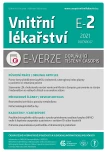-
Medical journals
- Career
Application of surgical mask with high-flow nasal cannula (HFNC) leads to improved oxygenation in patients with COVID-19: a set of case reports
Authors: Juraj Smaha; Martin Kužma; Kristína Brázdilová; Peter Jackuliak; Juraj Payer
Authors‘ workplace: V. interná klinika LF UK a UNB, Bratislava
Published in: Vnitř Lék 2021; 67(E-2): 29-33
Category: Case Reports
Overview
The new coronavirus SARS-CoV-2 is responsible for the development of acute infectious illness named COVID-19. While most people have a mild course of the disease, a significant minority of patients will develop some degree of respiratory insufficiency requiring hospitalization. In case of failure of conventional oxygen therapy, the method of choice in patients with respiratory insufficiency is ventilation with high-flow nasal cannula (HFNC). In order to reduce the dispersion of infectious aerosol during HFNC treatment, nasal cannula is often covered with a surgical mask in many hospitals. According to recent observations, the application of a surgical mask in these patients could also have a positive effect on oxygenation parameters without clinically relevant side effects. In the present set of case reports, we demonstrate this effective, simple and affordable way how to improve oxygenation in patients with COVID-19 and hypoxemic respiratory failure treated with HFNC.
Keywords:
COVID-19 – hypoxemic respiratory failure – high-flow nasal cannula
Sources
1. Choi H, Qi X, Yoon SH, et al. Extension of Coronavirus Disease 2019 (COVID-19) on Chest CT and Implications for Chest Radiograph Interpretation. Radiol Cardiothorac Imaging 2020; 2(2): e200107.
2. Wu Z, McGoogan JM. Characteristics of and Important Lessons From the Coronavirus Disease 2019 (COVID-19) Outbreak in China: Summary of a Report of 72 314 Cases From the Chinese Center for Disease Control and Prevention. JAMA 2020; 323(13): 1239–1242.
3. Alhazzani W, Møller MH, Arabi YM, et al. Surviving Sepsis Campaign: Guidelines on the Management of Critically Ill Adults with Coronavirus Disease 2019 (COVID-19). Crit Care Med. 2020; 48(6): e440–e469.
4. Ward JJ. High-flow oxygen administration by nasal cannula for adult and perinatal patients. Respir Care 2013; 58(1): 98–122.
5. Sotello D, Rivas M, Mulkey Z, et al. High-flow nasal cannula oxygen in adult patients: a narrative review. Am J Med Sci 2015; 349(2): 179–185.
6. Helviz Y, Einav S. A Systematic Review of the High-flow Nasal Cannula for Adult Patients. Crit Care 2018; 22(1): 71.
7. Agarwal A, Basmaji J, Muttalib F, et al. High-flow nasal cannula for acute hypoxemic respiratory failure in patients with COVID-19: systematic reviews of effectiveness and its risks of aerosolization, dispersion, and infection transmission. Can J Anaesth 2020; 67(9): 1217–1248.
8. Li J, Fink JB, Ehrmann S. High-flow nasal cannula for COVID-19 patients: low risk of bio - -aerosol dispersion. Eur Respir J 2020; 55(5): 2000892.
9. Montiel V, Robert A, Robert A, et al. Surgical mask on top of high-flow nasal cannula improves oxygenation in critically ill COVID-19 patients with hypoxemic respiratory failure. Ann Intensive Care 2020; 10(1): 125.
10. Lee CC, Mankodi D, Shaharyar S, et al. High flow nasal cannula versus conventional oxygen therapy and non-invasive ventilation in adults with acute hypoxemic respiratory failure: A systematic review. Respir Med 2016; 121 : 100–108.
11. Martin LD, Mhyre JM, Shanks AM, et al. 3,423 emergency tracheal intubations at a university hospital: airway outcomes and complications. Anesthesiology 2011; 114(1): 42–48.
Labels
Diabetology Endocrinology Internal medicine
Article was published inInternal Medicine

2021 Issue E-2-
All articles in this issue
- Serum butyrylcholinesterase/HDL-cholesterol ratio and atherogenic index of plasma in patients with fatty liver disease
- Comparison of LDL-C calculation by Martin, Sampson and old Friedewald methods in real data and synthetic data set
- Rheumatoid arthritis and metabolic disorders
- Non-pharmacological treatment of gout
- Application of surgical mask with high-flow nasal cannula (HFNC) leads to improved oxygenation in patients with COVID-19: a set of case reports
- Primary pneumococcal peritonitis with a fulminant course
- Screening for risk alcohol use in clinical settings
- RECENZE MONOGRAFIE SRDEČNÍ SELHÁNÍ
- Internal Medicine
- Journal archive
- Current issue
- Online only
- About the journal
Most read in this issue- Non-pharmacological treatment of gout
- Serum butyrylcholinesterase/HDL-cholesterol ratio and atherogenic index of plasma in patients with fatty liver disease
- Rheumatoid arthritis and metabolic disorders
- Screening for risk alcohol use in clinical settings
Login#ADS_BOTTOM_SCRIPTS#Forgotten passwordEnter the email address that you registered with. We will send you instructions on how to set a new password.
- Career

